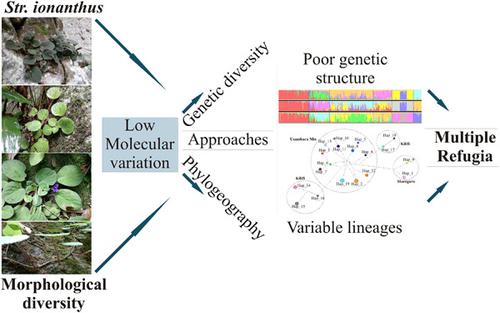当前位置:
X-MOL 学术
›
J. Syst. Evol.
›
论文详情
Our official English website, www.x-mol.net, welcomes your
feedback! (Note: you will need to create a separate account there.)
Multiple Pleistocene refugia and recent diversification for Streptocarpus ionanthus (Gesneriaceae) complex: Insights from multiple molecular sources
Journal of Systematics and Evolution ( IF 3.4 ) Pub Date : 2020-07-08 , DOI: 10.1111/jse.12658 Cornelius M. Kyalo 1, 2, 3 , Ling‐Yun Chen 1, 3 , Mathias Lema 4 , Itambo Malombe 5 , Guang‐Wan Hu 1, 3 , Qing‐Feng Wang 1, 3
Journal of Systematics and Evolution ( IF 3.4 ) Pub Date : 2020-07-08 , DOI: 10.1111/jse.12658 Cornelius M. Kyalo 1, 2, 3 , Ling‐Yun Chen 1, 3 , Mathias Lema 4 , Itambo Malombe 5 , Guang‐Wan Hu 1, 3 , Qing‐Feng Wang 1, 3
Affiliation

|
Streptocarpus ionanthus (Gesneriaceae) is endemic to Tanzania and Kenya, distributed in Tanga, Morogoro, and Kilifi regions. The species houses nine subspecies characterized by complex morphotypes and poorly understood evolutionary relationships, and thus is an ideal model for investigating evolutionary dynamics over time. Using multiple methods, we sought to test our hypothesis that the infraspecific taxa in Str. ionanthus are slightly variable and evolving populations. We first examined the genetic diversity, population differentiation, and phylogeographic structure among the populations of Str. ionanthus using both chloroplast and nuclear markers. We then estimated the divergence time of Str. ionanthus lineages and modeled past and future distribution. Despite Str. ionanthus exhibiting bottleneck events across its range, the populations maintain relatively high genetic diversity attributed to historical population admixture or local adaptation arising from habitat heterogeneity. The phylogeographic and genetic structure revealed a high connection among the Usambara mountains populations, while molecular dating suggested most diversification of haplotypes began ~1.32–0.18 million years ago and intensified toward the present, a conclusion of recent diversification. Phylogenetic relationship of Str. ionanthus cpDNA haplotypes revealed five main lineages with unique haplotypes that could be suggestive of past isolated refugia during the Pleistocene climate shifts. According to niche modeling, the stability of suitable areas during the Last Glacial Maximum (LGM) offered protective micro-habitats that have preserved the genetic diversity of Str. ionanthus to date. In conclusion, our findings suggest a complex Str. ionanthus with slightly variable lineages or populations attributed to multiple refugia and on the verge of divergence.
中文翻译:

多更新世避难所和最近的 Streptocarpus ionanthus (Gesneriaceae) 复合体的多样化:来自多个分子来源的见解
Streptocarpus ionanthus (Gesneriaceae) 是坦桑尼亚和肯尼亚的特有种,分布于坦噶、莫罗戈罗和基利菲地区。该物种拥有九个亚种,其特征是复杂的形态类型和对进化关系知之甚少,因此是研究随时间推移的进化动力学的理想模型。使用多种方法,我们试图检验我们的假设,即Str中的种下分类群。ionanthus是略有不同且不断发展的种群。我们首先检查了Str种群之间的遗传多样性、种群分化和系统地理结构。ionanthus使用叶绿体和核标记。然后我们估计了Str的发散时间. ionanthus谱系和模拟过去和未来的分布。尽管Str。ionanthus在其范围内表现出瓶颈事件,种群保持相对较高的遗传多样性归因于历史种群混合或栖息地异质性引起的局部适应。系统地理学和遗传结构揭示了乌桑巴拉山脉种群之间的高度联系,而分子测年表明,大多数单倍型的多样化始于约 1.32-018 万年前,并朝着现在加剧,这是最近多样化的结论。Str的系统发育关系。火龙果cpDNA 单倍型揭示了五个具有独特单倍型的主要谱系,这可能暗示了更新世气候变化期间过去孤立的避难所。根据生态位模型,末次盛冰期 (LGM) 期间适宜区域的稳定性提供了保护性微生境,从而保留了Str的遗传多样性。ionanthus迄今为止。总之,我们的研究结果表明一个复杂的Str。ionanthus具有略微不同的谱系或种群,归因于多个避难所并处于分歧的边缘。
更新日期:2020-07-08
中文翻译:

多更新世避难所和最近的 Streptocarpus ionanthus (Gesneriaceae) 复合体的多样化:来自多个分子来源的见解
Streptocarpus ionanthus (Gesneriaceae) 是坦桑尼亚和肯尼亚的特有种,分布于坦噶、莫罗戈罗和基利菲地区。该物种拥有九个亚种,其特征是复杂的形态类型和对进化关系知之甚少,因此是研究随时间推移的进化动力学的理想模型。使用多种方法,我们试图检验我们的假设,即Str中的种下分类群。ionanthus是略有不同且不断发展的种群。我们首先检查了Str种群之间的遗传多样性、种群分化和系统地理结构。ionanthus使用叶绿体和核标记。然后我们估计了Str的发散时间. ionanthus谱系和模拟过去和未来的分布。尽管Str。ionanthus在其范围内表现出瓶颈事件,种群保持相对较高的遗传多样性归因于历史种群混合或栖息地异质性引起的局部适应。系统地理学和遗传结构揭示了乌桑巴拉山脉种群之间的高度联系,而分子测年表明,大多数单倍型的多样化始于约 1.32-018 万年前,并朝着现在加剧,这是最近多样化的结论。Str的系统发育关系。火龙果cpDNA 单倍型揭示了五个具有独特单倍型的主要谱系,这可能暗示了更新世气候变化期间过去孤立的避难所。根据生态位模型,末次盛冰期 (LGM) 期间适宜区域的稳定性提供了保护性微生境,从而保留了Str的遗传多样性。ionanthus迄今为止。总之,我们的研究结果表明一个复杂的Str。ionanthus具有略微不同的谱系或种群,归因于多个避难所并处于分歧的边缘。











































 京公网安备 11010802027423号
京公网安备 11010802027423号